

Massive meteor that slammed into Russia in February left cosmic dust that showered Earth for MONTHS. According to NASA's Suomi NPP weather satellite, the meteor left behind hundreds of tones of microscopic rubbleDetonated 15 miles above the city of Chelyabinsk on February 15, injuring more than 1,000 peopleUsing the satellite's Ozone Mapping and Profiler Suite, NASA has released a video showing how the dust from the meteor was thrown up 28 miles and coated the EarthIt also left visible chunks on the ground for passers by to pick up By Daily Mail Reporter Published: 19:14 GMT, 18 August 2013 | Updated: 08:00 GMT, 19 August 2013 The bus-sized meteor that slammed into Russia in February, injuring more than 1,000 people, setting off car alarms and shattering windows sent a plume of cosmic dust into the stratosphere that showered the Earth for three months.
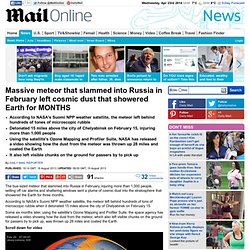
According to NASA's Suomi NPP weather satellite, the meteor left behind hundreds of tons of microscopic rubble when it detonated 15 miles above the city of Chelyabinsk on February 15. Scroll down for video. Asteroids, Meteors Explained: Phil Plait Talks Space Rocks, Impact Risks. The recent meteor strike over Chelyabinsk, Russia is reminding all of us just how vulnerable we are to attacks from above.

So I reached out to Phil Plait, who writes the Bad Astronomy column at Slate magazine. Because who better to talk to about asteroids than the author of a book called "Death From The Skies! "? To learn more, see the video above or click the link below to read the full transcript. And don't forget to comment at the bottom of the page. Come on, talk nerdy to me! Meteor shower later in May could turn out to be a STORM - with up to 1,000 shooting stars an HOUR. A remarkable new meteor shower is set to take place later this monthEvent will occur during the nights of 23 and 24 May in the US and CanadaThe origin of the shower is Comet 209P/LINEAR, first spotted in 2004But this will be the first time Earth has passed through its 'tail' of debrisAstronomers predict sky watchers might see up to 1,000 meteors an hour By Jonathan O'Callaghan Published: 11:14 GMT, 6 May 2014 | Updated: 11:39 GMT, 6 May 2014.
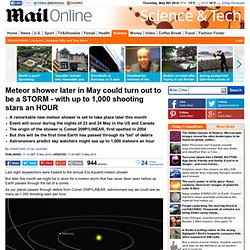
Perseid meteor shower: Spectacular reminder of a comet that won't pass by for 113 years. Perseid meteor shower happens annually between mid-July and mid-August but best views were expected last nightUp to 60 meteors an hour were visible from the comet Swift-Tuttle and won't be seen again until 2125Meteors are the result of small particles entering the Earth's atmosphere at high speed By Tara Brady Published: 08:50 GMT, 13 August 2013 | Updated: 06:38 GMT, 14 August 2013.
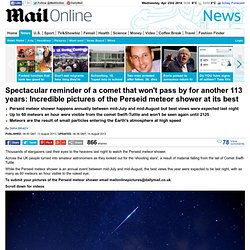
400-Meter-Wide Asteroid Could Hit Earth in 2032. MOSCOW, October 17 (RIA Novosti) – Ukrainian astronomers have discovered a large asteroid that could hit Earth in 2032, though the impact risk is minimal, according to current estimates.
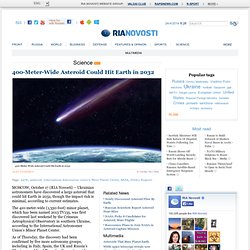
The 410-meter-wide (1,350-foot) minor planet, which has been named 2013 TV135, was first discovered last weekend by the Crimean Astrophysical Observatory in southern Ukraine, according to the International Astronomer Union’s Minor Planet Center. As of Thursday, the discovery had been confirmed by five more astronomy groups, including in Italy, Spain, the UK and Russia’s Siberian republic of Buryatia, the center said on its website. The asteroid has been classified as potentially hazardous, a formal tag given to celestial bodies whose orbits bring them closer than 7.5 million km from Earth’s orbit. Everything you need to know: Perseid meteor shower. In the Northern Hemisphere, the annual August Perseid meteor shower probably ranks as the all-time favorite meteor shower of the year.

This major shower takes place during the lazy, hazy days of summer, when many families are on vacation. And what could be more luxurious than taking a siesta in the heat of the day and watching this summertime classic in the relative coolness of night? This shower is visible in the Southern Hemisphere, too, though to a lesser extent. Perseid meteor shower 'at its most spectacular tonight'
The comet set to light up the sky: Hubble gets first glimpse of ISON as it moves closer to Earth. Comet could shine brighter than Venus or even the full moon in NovemberPhotographed on April 10, when it was 394 million miles from Earth By Mark Prigg.
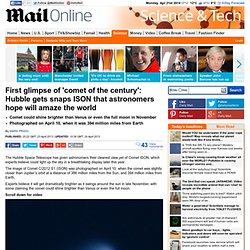
Hubble Captures Comet ISON. Newly discovered comet to fly-by the Earth giving stargazers spectacular views. Pan-STARRS is to come within 28 million miles of the sun this weekendFollows a spate of comet and asteroid sighting in 2013This is the closest the newly discovered ice ball has ever been to the Earth It will be visible in the Northern Hemisphere with binoculars By Emma Innes Published: 11:03 GMT, 8 March 2013 | Updated: 16:08 GMT, 8 March 2013 A recently discovered comet is closer to Earth than it has ever been - and stargazers in the Northern Hemisphere are finally going to be able to see it.
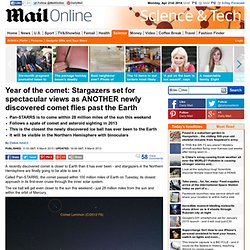
Good luck ISON! Astronomers hope 'comet of the century' will survive its close encounter with the sun this evening. At 18:35 GMT today astronomers will know if comet ISON has survived its closest approach to the sunThe comet, which is thought to measure less than a mile (1.6 kilometres) wide, will pass within 1.2 million kilometres of our starOne scientist from Joderell Bank Observatory it will be 'tough' for the comet to survive the sun's intense heat and huge gravitational pull By Jill Reilly and Sarah Griffiths.
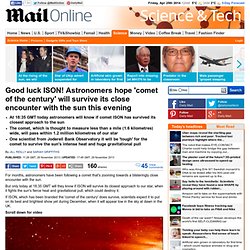
Forthcoming meteor showers in 2013. Edited by Tony Markham This guide has been compiled with visual observers in mind.
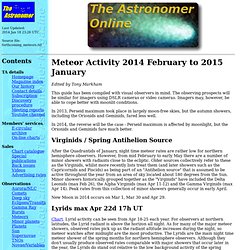
The observing prospects will be similar for imagers using DSLR cameras or video cameras. Imagers may, however, be able to cope better with moonlit conditions. In 2013, Perseid maximum took place in largely moon-free skies, but the autumn showers, including the Orionids and Geminids, fared less well. 2013 Meteor Showers. NOTES These are approximate times for the Lower 48 states; actual shower times can vary. Bright moonlight makes it difficult to see all but the brightest meteors. What is a meteor shower? A meteor shower is a spike in the number of meteors or "shooting stars" that streak through the night sky. Most meteor showers are spawned by comets. As a comet orbits the Sun it sheds an icy, dusty debris stream along its orbit.
Newly Found Asteroid to Pass Within Moon’s Orbit on March 4, 2013. Want to stay on top of all the space news? Follow @universetoday on Twitter A newly found asteroid, 2013 EC can be seen in the lower left corner of the red box in this image. ANOTHER close shave: Asteroid passes. Asteroid 2013 EC is between 10 to 17 metres wide - roughly the same size as the one which exploded above Russia's Ural mountains last month, injuring 1,000 peoplePassed between the moon and Earth at 7:37AM this morning Published: 16:43 GMT, 4 March 2013 | Updated: 12:43 GMT, 8 March 2013 Earth has had another close encounter with an asteroid.
Asteroid 2013 EC is between 10 to 17 metres wide - roughly the same size as the one which exploded above Russia's Ural mountains last month, injuring 1,000 people. It was discovered on March 2, and passed between the moon and sun 246,000 miles away in the early hours of this morning. Asteroids and Comet Watch. Meteor explodes over Russia. View the video Mother Nature took earthlings by surprise by exploding a meteor in the skies over Russia Friday morning. The boom occurred just hours before a much larger object was scheduled to pass the planet uneventfully at a distance of about 27,000 kilometers. The Russian meteor has no connection to the asteroid 2012 DA14, which will reach its closest point to Earth at 2:30 p.m.
Russia meteor virtually impossible to see coming. Scientists have begun piecing together the characteristics of the meteor that exploded over Russia on the morning of February 15, using data from seismic instruments that track earthquakes and microphones designed to detect sonic booms from nuclear explosions. Unlike the asteroid DA14, which narrowly but predictably missed Earth later that day, the meteor was too small to detect before its contrail appeared in the dawn skies over the Russian city of Chelyabinsk. Yet even an object too small to detect can produce an impressive amount of destruction. The meteor was 15 meters across (compared with 50 meters for 2012 DA14) and weighed more than 7,000 metric tons when it entered Earth’s atmosphere, says Margaret Campbell-Brown, an astronomer at Western University in London, Ontario. Coincidentally, the largest observed meteor to enter the atmosphere since 1908 arrived just hours before a much larger object passed the planet uneventfully at a distance of about 27,000 kilometers.
A miss is as good as a mile - but this asteroid is a very close shave. Space rock 150ft across set to whizz by just after Valentine's DayIt will miss our home planet by just 17,200 miles - close in cosmic termsAn impact would be equivalent to 2.25 megaton atom bomb. NASA time-lapse shows Lyrid meteor shower from space - as well as the Aurora Borealis and lightning strikes hitting the earth. By Eddie Wrenn Published: 15:07 GMT, 24 May 2012 | Updated: 08:57 GMT, 25 May 2012 Astronaut Don Pettit loves sharing his holiday pictures. Startling meteor display visible this weekend as annual Leonid meteor storm zooms over Britain.
Meteor explodes above Welsh town and wakes families with 'sonic boom' Fireball shot across the night sky before imploding in Cwmbran, near Newport, South WalesFirst spotted in the North West as it sped towards the border of Wales and the South West By Jill Reilly Published: 02:55 GMT, 29 August 2012 | Updated: 01:57 GMT, 30 August 2012 A golf ball-sized meteor caused panic in a Welsh town when it exploded, creating a massive sonic boom.' Hundreds of people saw the fireball shoot across the night sky before it exploded near their homes in Cwmbran, near Newport, South Wales. Police and coastguards in South Wales had dozens of reports of a bright flash in the sky followed by a loud bang. Comet 'brighter than the moon' will fly-by the Earth in 2013. By Eddie Wrenn. Stunning photos capture annual Perseid meteor shower blazing across star-spangled skies.
By Snejana Farberov Published: 23:41 GMT, 12 August 2012 | Updated: 12:38 GMT, 13 August 2012 Space enthusiasts who have spent the past few days admiring the stunning images of Martian landscapes beamed from NASA's Curiosity would have been well-advised to peel their eyes from their computer screens and look up into the night sky to catch a glimpse of one of the most spectacular celestial light shows. Asteroid Vesta: Nasa's Dawn probe reveals huge rippled asteroid is more like a small planet. Asteroid 2012 DA14 – Earth Flyby Reality Check. Update Feb. 15, 2013. Meteors, Comets & Asteroids. New Year's Quadrantids Meteor Show To Peak This Week - Space News. December 31, 2012 Brett Smith for redOrbit.com – Your Universe Online. The comet that could outshine the MOON: Sky-gazers anticipating 'unaided eye' object which could be the brightest for generations.
View the Eta Aquarid Meteor Shower from Halley’s Comet.